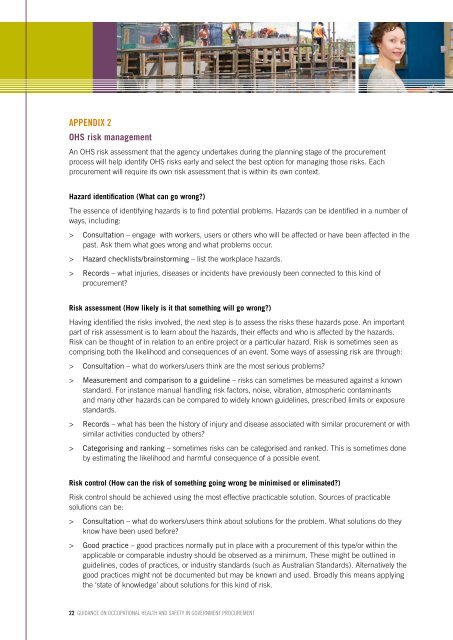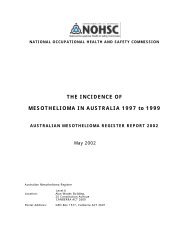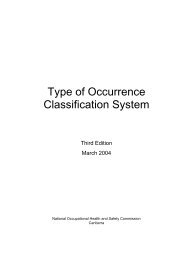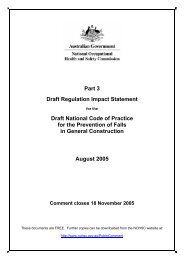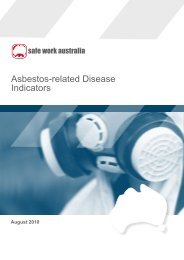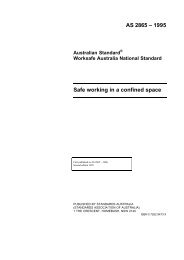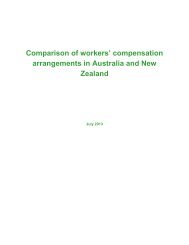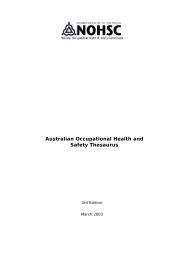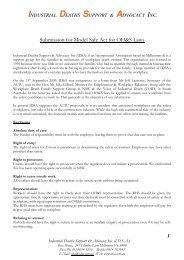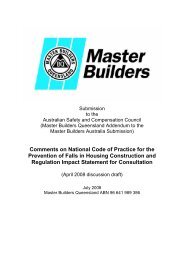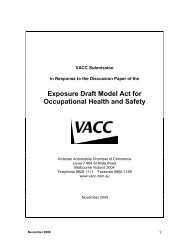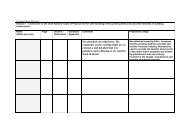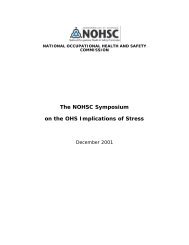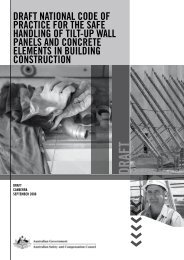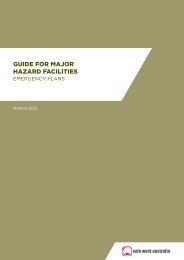Guidance on occuPaTionaL HeaLTH and SaFeTY in GoVeRnMenT
Guidance on occuPaTionaL HeaLTH and SaFeTY in GoVeRnMenT
Guidance on occuPaTionaL HeaLTH and SaFeTY in GoVeRnMenT
You also want an ePaper? Increase the reach of your titles
YUMPU automatically turns print PDFs into web optimized ePapers that Google loves.
APPENDIX 2<br />
OHS risk management<br />
An OHS risk assessment that the agency undertakes dur<strong>in</strong>g the plann<strong>in</strong>g stage of the procurement<br />
process will help identify OHS risks early <strong>and</strong> select the best opti<strong>on</strong> for manag<strong>in</strong>g those risks. Each<br />
procurement will require its own risk assessment that is with<strong>in</strong> its own c<strong>on</strong>text.<br />
Hazard identificati<strong>on</strong> (What can go wr<strong>on</strong>g?)<br />
The essence of identify<strong>in</strong>g hazards is to f<strong>in</strong>d potential problems. Hazards can be identified <strong>in</strong> a number of<br />
ways, <strong>in</strong>clud<strong>in</strong>g:<br />
><br />
><br />
><br />
C<strong>on</strong>sultati<strong>on</strong> – engage with workers, users or others who will be affected or have been affected <strong>in</strong> the<br />
past. Ask them what goes wr<strong>on</strong>g <strong>and</strong> what problems occur.<br />
Hazard checklists/bra<strong>in</strong>storm<strong>in</strong>g – list the workplace hazards.<br />
Records – what <strong>in</strong>juries, diseases or <strong>in</strong>cidents have previously been c<strong>on</strong>nected to this k<strong>in</strong>d of<br />
procurement?<br />
Risk assessment (How likely is it that someth<strong>in</strong>g will go wr<strong>on</strong>g?)<br />
Hav<strong>in</strong>g identified the risks <strong>in</strong>volved, the next step is to assess the risks these hazards pose. An important<br />
part of risk assessment is to learn about the hazards, their effects <strong>and</strong> who is affected by the hazards.<br />
Risk can be thought of <strong>in</strong> relati<strong>on</strong> to an entire project or a particular hazard. Risk is sometimes seen as<br />
compris<strong>in</strong>g both the likelihood <strong>and</strong> c<strong>on</strong>sequences of an event. Some ways of assess<strong>in</strong>g risk are through:<br />
><br />
><br />
><br />
><br />
C<strong>on</strong>sultati<strong>on</strong> – what do workers/users th<strong>in</strong>k are the most serious problems?<br />
Measurement <strong>and</strong> comparis<strong>on</strong> to a guidel<strong>in</strong>e – risks can sometimes be measured aga<strong>in</strong>st a known<br />
st<strong>and</strong>ard. For <strong>in</strong>stance manual h<strong>and</strong>l<strong>in</strong>g risk factors, noise, vibrati<strong>on</strong>, atmospheric c<strong>on</strong>tam<strong>in</strong>ants<br />
<strong>and</strong> many other hazards can be compared to widely known guidel<strong>in</strong>es, prescribed limits or exposure<br />
st<strong>and</strong>ards.<br />
Records – what has been the history of <strong>in</strong>jury <strong>and</strong> disease associated with similar procurement or with<br />
similar activities c<strong>on</strong>ducted by others?<br />
Categoris<strong>in</strong>g <strong>and</strong> rank<strong>in</strong>g – sometimes risks can be categorised <strong>and</strong> ranked. This is sometimes d<strong>on</strong>e<br />
by estimat<strong>in</strong>g the likelihood <strong>and</strong> harmful c<strong>on</strong>sequence of a possible event.<br />
Risk c<strong>on</strong>trol (How can the risk of someth<strong>in</strong>g go<strong>in</strong>g wr<strong>on</strong>g be m<strong>in</strong>imised or elim<strong>in</strong>ated?)<br />
Risk c<strong>on</strong>trol should be achieved us<strong>in</strong>g the most effective practicable soluti<strong>on</strong>. Sources of practicable<br />
soluti<strong>on</strong>s can be:<br />
><br />
><br />
C<strong>on</strong>sultati<strong>on</strong> – what do workers/users th<strong>in</strong>k about soluti<strong>on</strong>s for the problem. What soluti<strong>on</strong>s do they<br />
know have been used before?<br />
Good practice – good practices normally put <strong>in</strong> place with a procurement of this type/or with<strong>in</strong> the<br />
applicable or comparable <strong>in</strong>dustry should be observed as a m<strong>in</strong>imum. These might be outl<strong>in</strong>ed <strong>in</strong><br />
guidel<strong>in</strong>es, codes of practices, or <strong>in</strong>dustry st<strong>and</strong>ards (such as Australian St<strong>and</strong>ards). Alternatively the<br />
good practices might not be documented but may be known <strong>and</strong> used. Broadly this means apply<strong>in</strong>g<br />
the ‘state of knowledge’ about soluti<strong>on</strong>s for this k<strong>in</strong>d of risk.<br />
22 <str<strong>on</strong>g>Guidance</str<strong>on</strong>g> <strong>on</strong> OCCUPATIONAL HEALTH AND SAFETY IN GOVERNMENT PROCUREMENT


